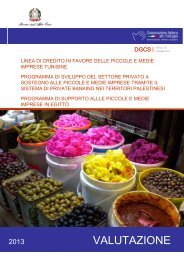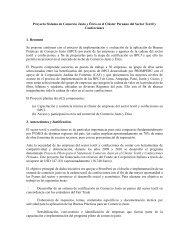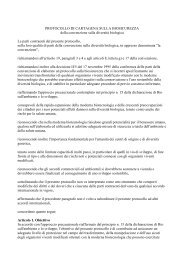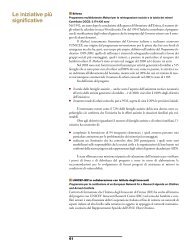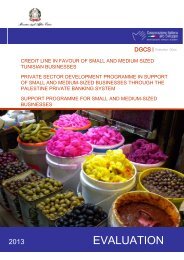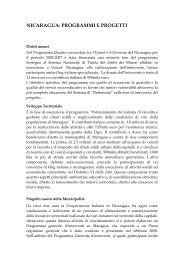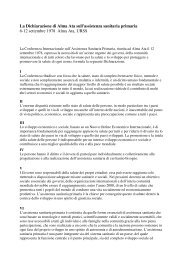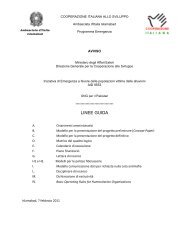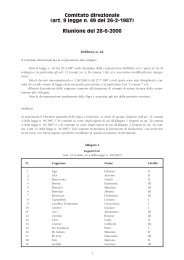Control between psychological subjection and resort to violencetowards the victim and her familyThe control exercised on the women is, according to numerous interviews, anextremely intense and pervasive control, even if it is manifested in forms that arevery different to those of our culture and is usually considered as an instrument ofsubjection and coercion.As we have seen the Nigerian women often have a wide possibility ofmovement: working outside the city, sometimes hundreds of kilometres from theplace of residence, they move in trains or by bus for long journeys without anyapparent control. One could ask the reason why they don’t escape from thissituation, considering the fact that normally the women live in groups in the houseof the madam, as well as the motives for the lack of rebellion or collective escapes.The answer is not connected to a particular acceptance or indifference towardsthe discomfort and suffering of the Nigerian women, nor is it a better capacity toaccept the work of prostitution in comparison to women of other origins: thesestereotyped images are the result of a false representation of their culture. Theapparent absence of rebellion is instead tied to rather more complex factors.In the first case the woman is tied by a rite and a pact which she has undertakenin the community: even if she does not really believe, intimately, in the threat ofthe wodoo rite, she is tied to maintaining the tight pact with the community, theinterruption of which is a source of dishonour and disgrace. The conditioning is sostrong that one can say it is a part of her character.In the second case, as evidenced previously, controls exist, notwithstanding thefact they are seemingly absent: the women are sometimes accompanied to the placeof work or at least to the railway station from w<strong>here</strong> they take the train during theday. In some cases, the collaborators of the madam undertake reconnaissancechecks and sometimes, at the end of the “shift”, someone re-accompanies them tothe house; often once at the house they are not free to go out.Obviously t<strong>here</strong> is a certain variation: the situation that they can encountershow different grades of control, varying not only from one person to another, butalso in relation to the various phases of the exploitation. For example it is quitefrequent that in the first months the madam controls the contacts of the womanwith her family in Nigeria, controls which, as the months pass, becomeconsiderably less.One should however remember that the margin of self-determination left to thewoman, sometimes apparently wide, is at the total discretion of the exploiter andher collaborators: the possibility of moving, communicating can be taken away orwidened without being influenced by the wishes of the woman in any way. In thissense we can talk about, at least in certain phases of the exploitation cycle, of“reduction to slavery”, undertaken however without constant constrictions andphysical violence 42 .42It should be mentioned that the Supreme Court, Corte di Cassazione, (Cass. S.U. 20.11.96/16.1.97No.261, ced. No. 206512) recognised that the reduction to slavery is identified by a de facto situation, forwhich the conduct of the agent to effect the reduction of the person offended in a material condition of
In addition not even in the Nigerian case is violence completely absent in t<strong>here</strong>lationship between the victims and exploiters. The context in which the womenfind themselves living is a violent context or, to use the words of a judge in thecourt of Rome interviewed by us, of “environmental violence”. By such anexpression it is intended that the context is however dominated by violence andoppression, even if not imparted with a hard, physical and direct violence in asystematic manner.This is the crucial aspect so as to understand the specific means of exploitation.The women may not suffer physical violence directly, but the fear of retaliation andviolence on the family or the stories of what happened to victims who rebelled isoften sufficient. Obviously at investigation level - in absence of evident physicalviolence and the lack of certainty regarding what happens in Nigeria - it is notalways easy to demonstrate the existence and relevance of such environmentalviolence.On the other hand, according to several people interviewed, the level of directviolence is increasing and is always more frequently passing from a psychologicaland symbolic level, to a level of reality. T<strong>here</strong> is a curious change taking place: insome areas, while the Nigerians are moving to more violence because of theincreasing difficulties in managing the women (also because of the interventions ofthe street units and pressure by the police) the Albanian exploiters, instead, are“Letting up on the violence, also because they understand that with the mobileunits, and protection programmes, they risk that the women escape and denouncethem, so they are becoming slightly more soft seeking to involve them, starting to<strong>allo</strong>w them to participate in some form of earnings…” (Cooperativa Dedalus -Naples).The Albanian exploiter, who was always considered the most violent 43 , ist<strong>here</strong>fore passing to softer systems of managing the victims, based on the divisionof profits. These are systems that make the victim in part an accomplice, risking togreatly weakening the position and credibility with the police and the NGOs whomust be able to adapt their interventions even with this type of change. It should benoted however that sometimes the tight pact between the woman and her exploiteris broken or modified and this can become a stimulus for complaints “TheUkrainian, Moldavian, Romanian, Albanian girls now know what they are comingto do, they know that t<strong>here</strong> is the famous 50 and 50. The complaint starts whenthey arrive in Italy and on the street, w<strong>here</strong> they know they have to go, t<strong>here</strong> is nolonger the 50 and 50, t<strong>here</strong> is 10 and 90 and the hitting starts” (Questura ofVenice).In each case it appears evident how the different organisations of exploitationmodel their strategies in relation to the needs of an efficacious reaction to theinitiatives of contrast, such as that represented by the permission to stay for socialprotection reasons.Returning to the Nigerian victims, these are also sometimes beaten (it is nearlyalways direct corporal violence, but they never use firearms and hardly ever otherslavery. That is her exclusive subjection to the power of disposition of someone.43This is what emerges from the testimony of the women and the operators.
- Page 1:
TRAFFICKINGOF NIGERIAN GIRLSTO ITAL
- Page 5 and 6:
F O R E W O R D1. Objectives and st
- Page 7 and 8:
and who have identified the most si
- Page 9 and 10:
on the other hand, for those involv
- Page 11:
Case files analysed: Preventive det
- Page 15 and 16:
Table 2 - Socio-economic situation
- Page 17 and 18:
Table 3 - Nigerian citizens regular
- Page 19 and 20:
Table 5 - Social protection permiss
- Page 21 and 22:
Table 7 - Number of persons charged
- Page 23 and 24:
Table 8 - Detainee population sub-d
- Page 25 and 26:
and the United States enables this
- Page 27 and 28:
C H A P T E R IW a y s a n d p h a
- Page 29 and 30:
Figure No.2 - Edo State.It is not c
- Page 31 and 32:
Nigeria. From 1996 in Benin City an
- Page 33 and 34:
In this variegated framework, the d
- Page 36:
“Benin City is one of those State
- Page 39 and 40: Various privileged witnesses of the
- Page 41 and 42: In the first years of the traffic o
- Page 43 and 44: pay considerable sums for lodging,
- Page 45 and 46: The routesWe find at least three ty
- Page 47 and 48: Figure No.5 - Trafficking routes th
- Page 49 and 50: The journey overland through Africa
- Page 51 and 52: new dispositions and contacts to co
- Page 53 and 54: Then he sends her in a taxi to the
- Page 55 and 56: T. remains in this house for 21 day
- Page 57 and 58: detainees go towards the refectory,
- Page 59 and 60: At this point the organisation esco
- Page 61 and 62: was accepted by the Ivory Coast pol
- Page 63 and 64: B.E. «Yes, I was given a Ghanaian
- Page 65 and 66: Now the documents are “hired”:
- Page 67 and 68: It is understood however that the v
- Page 69 and 70: “There is no Nigerian passport wh
- Page 72 and 73: C H A P T E R I VL i v i n g a n d
- Page 74 and 75: have no shop and then there is no p
- Page 76 and 77: The cost to manage the house and th
- Page 78 and 79: mine since a long time, he can’t
- Page 80 and 81: A feminine managementIn analysing t
- Page 82 and 83: “There are many pimps that when y
- Page 84 and 85: The control of movementThe fact tha
- Page 86 and 87: Physical punishments can be made by
- Page 90 and 91: arms), tortured in many different f
- Page 92 and 93: C H A P T E R VT h e o r g a n i s
- Page 94 and 95: Each penal procedure on the subject
- Page 96 and 97: Often it is the same madam who move
- Page 98 and 99: Even in numerous recent criminal pr
- Page 100 and 101: work arrangements (…) persons tha
- Page 102 and 103: man all the money she had in the ho
- Page 104 and 105: in the plates and everything and th
- Page 106 and 107: exploitation) has reached an amount
- Page 108 and 109: C H A P T E R V IT h e e n d o f t
- Page 110 and 111: A: «You have to bring me a present
- Page 112 and 113: Often the family is however not abl
- Page 114 and 115: the different evaluations of the as
- Page 116 and 117: The discussions on the possibility
- Page 118 and 119: eal results: to distance herself fr
- Page 120 and 121: of a different culture is very impo
- Page 122 and 123: C H A P T E R V I IC o n s i d e r
- Page 124 and 125: In the case of the girls having mor
- Page 126 and 127: As has been many times noted, the c
- Page 128 and 129: under the profile of the “quality
- Page 130 and 131: person to obtain either relevant re
- Page 132 and 133: Numerous are the criminal juridical
- Page 134 and 135: If the accused claims to not knowin
- Page 136 and 137: sanctions, sometimes, also in prese
- Page 138 and 139:
d) Investigative and judiciary co-o
- Page 140 and 141:
The reform foresees, under Art. 1,
- Page 142 and 143:
which the woman can definitively tu
- Page 144 and 145:
witnesses, social operators - agree
- Page 146:
and necessary, therefore, to think
- Page 149 and 150:
in many cases they are driven to th
- Page 151 and 152:
Melossi, D., (2002), “Le teorie s




